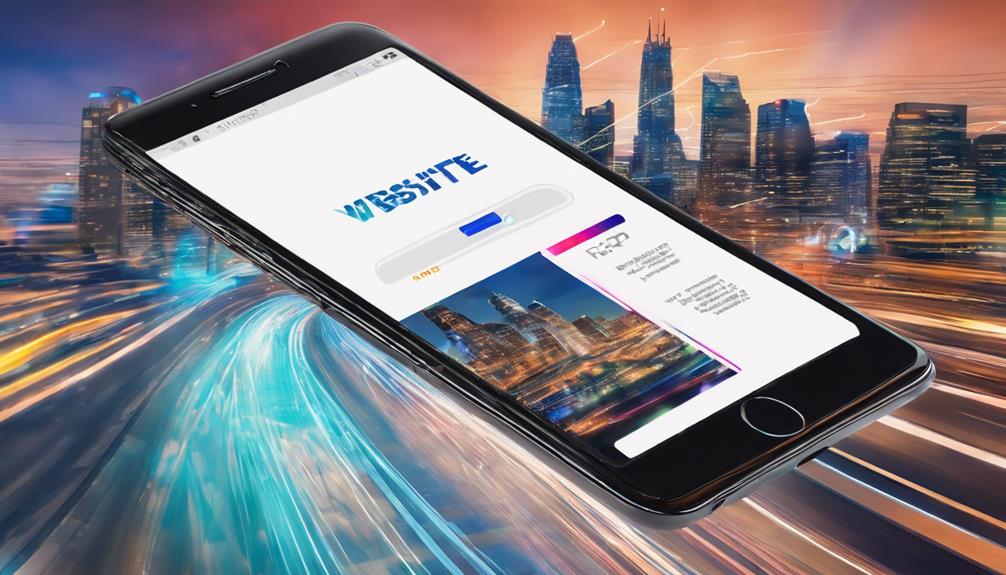Did you know that over 50% of global web traffic comes from mobile devices? This staggering statistic underscores the importance of mobile optimization for SEO. As users increasingly rely on their smartphones for online searches, it's crucial to ensure your website meets their needs. A mobile-friendly site not only improves user experience but also aligns with Google's mobile-first indexing. Are you curious about how this shift in user behavior impacts your search rankings and conversion rates? Let's explore the strategies that can keep your business competitive in this mobile-driven world.
Understanding Mobile User Behavior
Understanding mobile user behavior is crucial for optimizing your site for SEO. In today's digital landscape, over 50% of global web traffic originates from mobile devices. This shift necessitates a deep dive into how users interact with your mobile site.
Start by analyzing bounce rates, session durations, and user flows using tools like Google Analytics. High bounce rates on mobile could indicate slow loading times or unresponsive design elements, which are detrimental to SEO rankings.
Focus on user intent by assessing keyword performance across mobile devices. Mobile search queries often differ from desktop due to context and immediacy. Use Google Search Console to compare mobile and desktop keyword rankings, paying attention to voice search trends. Voice searches are typically longer and more conversational, requiring a strategy shift toward long-tail keywords.
Evaluate your site's speed and responsiveness. Google's PageSpeed Insights can help identify elements slowing down your mobile site. Aim for a load time under three seconds; longer times can lead to increased abandonment rates, affecting your SEO negatively.
Implement Accelerated Mobile Pages (AMP) to enhance speed and user experience.
Consider how navigation impacts user behavior. Mobile users prefer intuitive, thumb-friendly navigation. Utilize heatmaps to see where users most frequently tap, ensuring critical paths are easy to navigate.
Simplified navigation reduces friction and keeps users engaged longer, which is favorable for SEO.
Enhancing Local Search Visibility

Maximizing your site's performance for mobile users lays a strong foundation for enhancing local search visibility. Mobile optimization is crucial because over 60% of all searches originate from mobile devices, and nearly one-third of all mobile searches are related to location. To effectively capture this audience, you must focus on optimizing your site to meet the needs of local searchers.
Consider the following data to understand the significance:
| Aspect | Mobile User Behavior (%) | Impact on Local Search Visibility |
|---|---|---|
| Searches with Local Intent | 76% | Drives foot traffic |
| Users Visiting Store | 50% | Increases in-store conversions |
| Searches Leading to Purchase | 28% | Boosts sales opportunities |
| "Near me" Search Growth | 150% | Enhances local SEO ranking |
| Mobile-Friendly Sites | 67% | Reduces bounce rate |
Local search visibility isn't just about being found; it's about converting those searches into real-world interactions. By ensuring your site is mobile-friendly, you're directly impacting the likelihood of users visiting your physical location. The "near me" searches have grown exponentially, with a 150% increase over recent years, which highlights the need to target these queries effectively.
Moreover, a seamless mobile experience reduces bounce rates and encourages users to engage with your content. Optimizing for mobile means faster load times, easy navigation, and relevant local content. By analyzing user behavior, leveraging local keywords in your content, and ensuring NAP (Name, Address, Phone) consistency across platforms, you can enhance your local search visibility. This strategic approach aligns your mobile optimization efforts with tangible business outcomes, driving foot traffic and boosting sales.
Boosting Mobile Site Speed

A speedy mobile site is crucial for retaining users and enhancing your site's search visibility. Mobile site speed directly impacts user experience and search engine rankings. When your site loads slowly, users become frustrated and leave, increasing your bounce rate. Google's algorithms prioritize fast-loading sites, so improving speed can boost your search visibility.
Start by measuring your current site speed using tools like Google's PageSpeed Insights. This tool provides a performance score based on several metrics, such as First Contentful Paint (FCP) and Time to Interactive (TTI). Aim for an FCP under 1.8 seconds and a TTI under 3.8 seconds. These benchmarks align with top-performing mobile sites.
Optimize images to reduce load times. Use image formats like WebP and apply compression techniques to decrease file size without sacrificing quality. Leverage browser caching to store static resources, reducing the number of requests needed for returning visitors.
Minimize JavaScript and CSS files by removing unnecessary code and reducing file sizes. You can utilize tools like UglifyJS and CSSNano for minification. Implement asynchronous loading for JavaScript to prevent rendering-blocking.
Evaluate server response times. Aim for a server response time under 200 milliseconds. Consider using a content delivery network (CDN) to distribute site content across multiple servers, reducing latency for users globally.
Implementing Mobile-Friendly Design

Design plays a pivotal role in creating mobile-friendly websites that enhance user experience and boost search engine rankings. To implement a mobile-friendly design, you must prioritize responsive design principles. A responsive design ensures that your website adjusts seamlessly to different screen sizes, which is critical as over 50% of web traffic now originates from mobile devices.
Google's mobile-first indexing also makes this a necessity, as it predominantly uses the mobile version of content for ranking and indexing.
Start by utilizing flexible grid layouts and scalable images. This approach allows your content to adapt to various screen dimensions without losing its integrity or causing excessive load times, which could negatively affect your SEO performance.
Ensure that touch elements, like buttons and navigation links, are optimally sized and spaced to enhance usability and reduce user frustration.
Testing is crucial in this process. Utilize tools like Google's Mobile-Friendly Test to evaluate your site's mobile compatibility. This tool provides actionable insights into areas needing improvement, such as text readability without zoom and the absence of horizontal scrolling.
Data from these tests can guide iterative adjustments, ensuring your design aligns with both user expectations and search engine guidelines.
Consider implementing Accelerated Mobile Pages (AMP) to enhance page speed and user engagement further. AMP's streamlined HTML and CSS framework reduces load times significantly, which can positively impact your search rankings.
Leveraging Local Mobile Keywords

While optimizing for mobile SEO, leveraging local mobile keywords is essential for driving targeted traffic and enhancing your site's visibility in local search results. Mobile users frequently search with location-specific intent, making it crucial to focus on keywords that reflect local interests and behaviors. This approach not only aligns with user intent but also increases your chances of ranking higher in mobile search results.
To effectively utilize local mobile keywords, first, conduct thorough keyword research. Use tools like Google Keyword Planner or SEMrush to identify search terms with high local relevance. Pay attention to metrics such as search volume and competition level. Consider the following table for guidance:
| Metric | Importance |
|---|---|
| Search Volume | Indicates potential traffic |
| Competition | Assesses difficulty to rank |
| Local Relevance | Aligns with user intent |
Incorporating these keywords into your content involves strategic placement. Ensure they appear in titles, meta descriptions, headings, and throughout the content. However, avoid keyword stuffing, which can negatively impact user experience and SEO rankings. Instead, aim for a natural integration that enhances the readability and relevance of your content.
Furthermore, consider the impact of mobile-specific features, such as voice search. As voice search continues to rise, optimizing for long-tail, conversational local keywords becomes imperative. Users often phrase voice searches differently, so tailor your content to accommodate these variations.
Conclusion
Think of your website as a bustling city. If the streets (your mobile site) are well-paved and optimized, traffic flows smoothly, leading to thriving businesses (higher conversions). But if they're neglected, gridlock ensues, stalling growth (higher bounce rates). By prioritizing mobile optimization, you ensure your city thrives, adapting to the modern traveler (mobile user). Remember, Google's mobile-first indexing acts as the city planner, rewarding those who build with precision and foresight in this digital age.


Leave a Reply